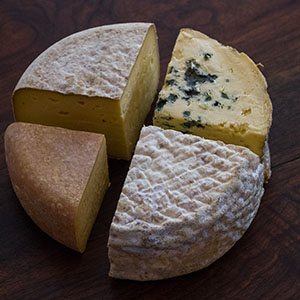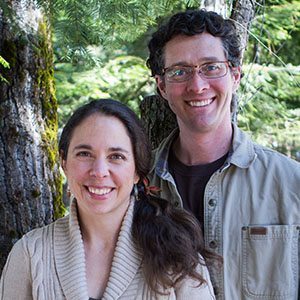Nestled in the shadow of Mount Adams, about 20 miles north of the Columbia River, sits the tiny town of Trout Lake, WA, population 557. Here, Cascadia Creamery, is reviving a cheesemaking tradition that dates back 125 years.
No doubt about it, this is rural country. The White Salmon River runs, wild and scenic, next to the highway that takes you up nearly 2,000 feet into the high country.
Outposts of backwoods lifestyle — river rafting, hiking and outdoor adventure companies — line the highway heading up to town.
A hallmark of this region is the rich volcanic soils and natural lava tube caves which early settlers used for everything from storing potatoes to aging cheese. Though “Cheese Cave” appears on historical maps, no cheese had been made in Trout Lake for decades.
That is, until an idealistic and hard working young couple, John and Marci Shuman, settled here, envisioning a small town life with close ties to the land as the home base for their growing family.
Deep Dairy History
The first settlers arrived in the 1880’s, many of them from Switzerland and Sweden. Surely, the sub-alpine meadows and picturesque vistas must have conjured visions of their old country. These early settlers came here with cows in tow, specifically to dairy.
Because the area was so remote, it was one of the very last in the United States to get tied to the ‘modern’ electrical grid, which was established in nearby Portland, OR as early as the 1890s. This necessitated that local cheesemaking and dairy practices be kept more traditional.

As a result, for decades, the 30 or so early dairy families pooled their milk and made butter and cheese, which could more easily be transported and sold in larger cities and towns.
During the World Wars, when European cheeses were unavailable, a U.S. government study revealed two American caves matching the temperature, humidity and airflow profile of the famous Roquefort caves. One was in Trout Lake.
A local cheesemaker jumped on board and, for about a decade, a noteworthy Roquefort-style cheese was produced and aged in the cave. This era came to an end when human dramas of divorce and dissolution brought that creamery to a close.
At the time, artisan cheesemaking was falling into obscurity nationally and consolidation changed the face of small dairy communities everywhere. The number of dairies in town dwindled to just a few of the original families. It seemed like the cheese heritage of the region might be lost forever.
Enter A New Cheesemaker

Weary of their urban life in Portland and wanting a back-to-the-land change, the Shumans acquired their 5 acres of creek-front property and built a cozy, wood home. Cheese wasn’t yet on the radar as the couple welcomed the first of their two children to the family. Today, their son Rowan is 9, and daughter Ella, is 5.
“When we first moved here, I wanted to be economically and socially a part of this community, not coming in as outsiders and trying to make this into Portland,” says John. “I wanted to know what made things tick here and one of those things was dairy heritage. I set about meeting people and creating a business and a life that was in stride with the soul of the town.”
John approached a local fourth generation dairyman, Travis Pearson, of Mountain Laurel Jerseys, with a request. “I wanted to learn everything there is to know about dairy. My time in exchange for the learning.”
It was an internship of sorts, with an eye toward being a farmstead creamery. In exchange for his efforts at the dairy, Shuman asked to be paid in milk and soon began developing cheese recipes that reflect the terroir of the region.
“We originally thought we’d be making cheese for our neighbors. We didn’t expect it would go as far as it has,” notes John.
With early recipes for Cascadia Blue and their aged cheese, Sleeping Beauty, showing promise, the couple began the arduous process of creamery construction, licensing and training a team of locals to make and ripen cheese.
A small and efficient creamery and aging cave were constructed adjacent to their home, and officially licensed in 2010. Cheeses sold briskly at local farmers markets in Hood River and Trout Lake and met with hearty support and approval from Portland cheese shops and distributors.
As word spread, Marci, sales and marketing manager for the operation, was soon fielding calls from regional and even national cheese shops interested in carrying their products.

Milk is the make it or break it main ingredient of any cheese. For an operation that focuses on raw milk cheese, quality and proximity is key.
In this case, milk comes from the nearby Pearson dairy, which sells fluid milk to Organic Valley Dairy. “When I started my internship, they had a registered Jersey herd. Jersey milk is great for butter and gets good creamlines in fluid milk, but the fat molecules are larger and separate out, so it’s not ideal for cheesemaking,” says John.
“As the herd grew and Travis took over from the previous generation, he was open to develop a herd that was good for cheese. We selected genetics for breeds that would thrive on a grass-based rather than grain-based diet and not suffer through the cold winters for lack of calories.”
The herd now includes Fresian and Dutch Belt genetics, breeds that fit the bill for a cheesemaking super herd.
The Cheeses
Cascadia Creamery is well known for four distinct cheeses, all reflecting the local area. Names were chosen from the natural wonderland around them and influenced by the Northwest native tribes who have inhabited the region for thousands of years.
For nearly 10,000 years, native people have gathered at the nearby Indian Heaven Wilderness, a 20,000-acre area of sub-alpine meadows and rolling country along the crest of the Cascade Range. Here, each summer, huckleberries are harvested at the Sawtooth Berry Fields.

Sawtooth, the creamery’s foray into the realm of stinky — but not too stinky deliciousness — is named after this ancient gathering spot. This smear-rinded cheese is aged 60–75 days and has a dense and fudgy texture and a balanced complexity that begs for another bite.
The aged and gorgeously wrapped Sleeping Beauty lives up to her name, inside and out. The cheese is named for a Klicktitat Indian legend about a local rock formation resembling a woman lying down in the shadow of Mount Adams.
Legend tells of a beautiful Indian princess admired by two braves, Pahto (Mount Adams) and Wyeast (Mount Hood). An epic battle ensued with both mountains fighting for her with molten lava. Their conflict brought down the ancient formation, the Bridge of the Gods. Eventually Mount Adams was victorious.
Secretly, the beautiful woman loved Mount Hood, and fell into an eternal slumber at the base of Mount Adams. Mount Hood, feeling proud, lifted his head into a high peak and Mount Adams bowed his head in shame, explaining the varied shape peaks.
Cloud Cap, is a close cousin of Sleeping Beauty, sporting a downy, cloud-like natural white rind. Named for the cloud formation that occurs when air is forced upwards by a mountain peak, the cheese has a bright, citrusy interior and visible ripening under the rind. The paste here has an earthier, mushroom-like flavor.
Rounding out the collection is the gorgeous Glacier Blue, bold-looking with its cave-like blue veins, but with a more mild-mannered bite. Balanced and approachable with a satisfying salt edge and fudge-like texture, this is a blue that will keep you coming back for more.
All cheeses are made with organic, raw milk and cave aged naturally.
Growing Into The Future

One day while John was on “cow observation duty” — watching for cows ready to give birth or in heat — he discovered a small hole with air rushing out in the middle of the pasture.
Later, he dropped a temperature and humidity gauge into the hole and saw readings of 52 degrees with 92 percent humidity, ideal cheese aging conditions. It was a light-bulb moment.
Over the next few years, the cave was excavated, and John set out to make the cave into a food safe environment.
“I wanted to use this natural resource to produce a modern day cheese, with impeccable sanitation standards while still having the living, breathing cave that could birth a cheese that reflected the local land.”
Construction is now underway on the new, nearly 5,000-square-foot creamery complete with fully functional caves transformed into a state of the art aging facility.
The Shumans expect to transfer cheesemaking, packaging and office operations to this new facility throughout the rest of 2016. When the facility is fully operational, production can increase to meet demand from as far away as New York City.
Look for Cascadia Creamery products at select Murray’s kiosks, Eataly NYC and Chicago and regional markets throughout the Northwest. CC



